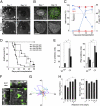High-resolution, noninvasive longitudinal live imaging of immune responses
- PMID: 21768391
- PMCID: PMC3150878
- DOI: 10.1073/pnas.1105002108
High-resolution, noninvasive longitudinal live imaging of immune responses
Abstract
Intravital imaging emerged as an indispensible tool in biological research, and a variety of imaging techniques have been developed to noninvasively monitor tissues in vivo. However, most of the current techniques lack the resolution to study events at the single-cell level. Although intravital multiphoton microscopy has addressed this limitation, the need for repeated noninvasive access to the same tissue in longitudinal in vivo studies remains largely unmet. We now report on a previously unexplored approach to study immune responses after transplantation of pancreatic islets into the anterior chamber of the mouse eye. This approach enabled (i) longitudinal, noninvasive imaging of transplanted tissues in vivo; (ii) in vivo cytolabeling to assess cellular phenotype and viability in situ; (iii) local intervention by topical application or intraocular injection; and (iv) real-time tracking of infiltrating immune cells in the target tissue.
Conflict of interest statement
Conflict of interest statement: P.-O.B. is one of the founders of the biotech company Biocrine, which is going to use the anterior chamber of the eye as a commercial servicing platform. A.C. and I.L. are also involved in the commercialization of this servicing platform.
Figures



References
-
- Martinic MM, von Herrath MG. Real-time imaging of the pancreas during development of diabetes. Immunol Rev. 2008;221:200–213. - PubMed
-
- Prescher A, Mory C, Martin M, Fiedler M, Uhlmann D. Effect of FTY720 treatment on postischemic pancreatic microhemodynamics. Transplant Proc. 2010;42:3984–3985. - PubMed
-
- Toso C, et al. Clinical magnetic resonance imaging of pancreatic islet grafts after iron nanoparticle labeling. Am J Transplant. 2008;8:701–706. - PubMed
-
- Ntziachristos V. Going deeper than microscopy: The optical imaging frontier in biology. Nat Methods. 2010;7:603–614. - PubMed
Publication types
MeSH terms
Substances
Grants and funding
- U42 RR016603/RR/NCRR NIH HHS/United States
- M01RR16587/RR/NCRR NIH HHS/United States
- M01 RR016587/RR/NCRR NIH HHS/United States
- F32 DK083226/DK/NIDDK NIH HHS/United States
- U01 DK070460/DK/NIDDK NIH HHS/United States
- U19 AI050864/AI/NIAID NIH HHS/United States
- U01DK089538/DK/NIDDK NIH HHS/United States
- U01 DK089538/DK/NIDDK NIH HHS/United States
- R01DK084321/DK/NIDDK NIH HHS/United States
- 1F32DK083226/DK/NIDDK NIH HHS/United States
- R03 DK075487/DK/NIDDK NIH HHS/United States
- 5U01DK70460-07/DK/NIDDK NIH HHS/United States
- R03DK075487/DK/NIDDK NIH HHS/United States
- R01 DK084321/DK/NIDDK NIH HHS/United States
- 5U19AI050864-10/AI/NIAID NIH HHS/United States
- R01DK55347-IU42RR016603/DK/NIDDK NIH HHS/United States
LinkOut - more resources
Full Text Sources
Other Literature Sources
Molecular Biology Databases

